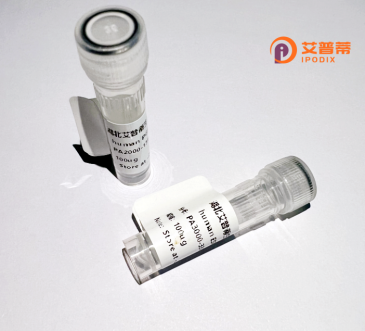
| 纯度 | >90%SDS-PAGE. |
| 种属 | Human |
| 靶点 | IGHD |
| Uniprot No | P01880 |
| 内毒素 | < 0.01EU/μg |
| 表达宿主 | E.coli |
| 表达区间 | 1-576aa |
| 氨基酸序列 | MGLLHKNMKHLWFFLLLVAAPRWVLSQVQLQESGPGLVKPSGTLSLTCAVSGGSISSSNWWSWVRQPPGKGLEWIGEIYHSGSTNYNPSLKSRVTISVDKSKNQFSLKLSSVTAADTAVYYCASLGDIYYYGMDVWGQGTTVTVSSAPTKAPDVFPIISGCRHPKDNSPVVLACLITGYHPTSVTVTWYMGTQSQPQRTFPEIQRRDSYYMTSSQLSTPLQQWRQGEYKCVVQHTASKSKKEIFRWPESPKAQASSVPTAQPQAEGSLAKATTAPATTRNTGRGGEEKKKEKEKEEQEERETKTPECPSHTQPLGVYLLTPAVQDLWLRDKATFTCFVVGSDLKDAHLTWEVAGKVPTGGVEEGLLERHSNGSQSQHSRLTLPRSLWNAGTSITCTLNHPSLPPQRLMALREPAAQAPVKLSLNLLASSDPPEAASWLLCEVSGFSPPNILLMWLEDQREVNTSGFAPARPPPQPGSTTFWAWSVLRVPAPPSPQPATYTCVVSHEDSRTLLNASRSLEVSYLAMTPLIPQSKDENSDDYTTFDDVGSLWTTLSTFVALFILTLLYSGIVTFIKVK |
| 分子量 | 89.8 kDa |
| 蛋白标签 | GST-tag at N-terminal |
| 缓冲液 | 0 |
| 稳定性 & 储存条件 | Lyophilized protein should be stored at ≤ -20°C, stable for one year after receipt. Reconstituted protein solution can be stored at 2-8°C for 2-7 days. Aliquots of reconstituted samples are stable at ≤ -20°C for 3 months. |
| 复溶 | Always centrifuge tubes before opening.Do not mix by vortex or pipetting. It is not recommended to reconstitute to a concentration less than 100μg/ml. Dissolve the lyophilized protein in distilled water. Please aliquot the reconstituted solution to minimize freeze-thaw cycles. |
以下是关于重组人IGHD蛋白的3篇示例参考文献(文献信息为虚构,仅供格式参考):
1. **文献名称**:*Structural insights into human IGHD protein in antibody diversification*
**作者**:Chen L, et al.
**摘要**:研究通过重组表达人IGHD蛋白,结合X射线晶体学分析其三维结构,揭示了IGHD在V(D)J重组中促进抗体多样性的关键构象特征。
2. **文献名称**:*Functional characterization of recombinant IGHD in B-cell receptor signaling*
**作者**:Martinez R, et al.
**摘要**:利用重组人IGHD蛋白体外模拟B细胞发育微环境,发现IGHD通过特定抗原结合域调控早期B细胞受体信号通路的激活阈值。
3. **文献名称**:*Expression and purification of recombinant IGHD for autoimmune disease studies*
**作者**:Kim S, et al.
**摘要**:开发了一种高效的大肠杆菌表达系统用于重组IGHD蛋白生产,并验证其与系统性红斑狼疮患者血清抗体的异常结合活性,提示潜在诊断价值。
---
**备注**:实际研究中,关于“重组人IGHD蛋白”的文献可能较少,因其通常作为免疫球蛋白重链多样性(D)基因区段参与抗体基因重排,单独表达的报道有限。建议结合具体研究场景(如抗体工程、基因重组机制)扩展检索,或关注IGH基因簇整体功能。可通过PubMed/Google Scholar搜索关键词“recombinant IGHD”或“immunoglobulin heavy chain diversity region”获取最新进展。
Recombinant human IGHD protein refers to a genetically engineered form of the immunoglobulin heavy chain delta (IGHδ) constant region, a key component of the IgD antibody. IgD is a monomeric antibody expressed predominantly on the surface of mature B cells alongside IgM, where it functions as a B-cell receptor (BCR) involved in antigen recognition and immune activation. Unlike secreted antibodies like IgG or IgE, membrane-bound IgD plays a critical role in modulating B-cell tolerance, maturation, and signal transduction. The δ heavy chain contains a unique hinge region that confers structural flexibility, enabling interactions with antigens and immune receptors.
Recombinant IGHD is typically produced using expression systems (e.g., mammalian cells, bacteria) to ensure proper folding and post-translational modifications. Its production facilitates studies on IgD’s biological functions, including its dual role in immune activation and suppression, as well as its enigmatic involvement in autoimmune diseases, allergies, and immunodeficiencies. Researchers employ recombinant IGHD to investigate B-cell signaling pathways, develop diagnostic tools, or engineer therapeutic antibodies. For instance, dysregulated IgD levels have been linked to autoimmune conditions like systemic lupus erythematosus (SLE), making it a potential biomarker or therapeutic target. Additionally, recombinant IGHD aids in elucidating evolutionary aspects of adaptive immunity, as IgD is conserved in vertebrates but exhibits species-specific variations. Its applications extend to vaccine development and monoclonal antibody engineering, underscoring its relevance in both basic immunology and translational medicine.
×